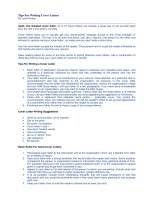Watercolour tips for beginners doc
Bạn đang xem bản rút gọn của tài liệu. Xem và tải ngay bản đầy đủ của tài liệu tại đây (86.83 KB, 7 trang )
Watercolour tips for
beginners
Working with watercolour may at first seem strange and difficult, especially
if you are use to opaque mediums such as oil or acrylic. The first and most
obvious difference is the fact that watercolour is transparent. This means you
must decide from the very beginning where the areas of white will be in
your painting.
The process for successful watercolour painting, is to avoid the areas to be
left white and apply the lightest washes first, gradually working your way
towards darker washes. Try to cover large areas fairly loosely in the early
stages of the painting, applying tighter detail towards the end.
Here are a few points to keep in mind
Thumbnails
Small thumbnail sketches allow you to shuffle your subject around and
adjust the composition before you start to paint. Having a plan to work to
makes it much easier to avoid problems, particularly when it comes to
arranging tonal (light dark) contrast. Break your thumbnail sketches into
about four different tonal areas and shade them in. This lets you manipulate
the lights and darks so the maximum contrast occurs at the centre of interest.
this sketch contains only four different tones (black, dark. grey, light.grey,
white)
Colour harmony
There are a few things to remember to maintain colour harmony throughout
your painting.
Limit your palette
Dipping into twenty different colours spread around your palette is tempting
but usually results in a discordant, muddy work. Limit your colours to just
two or three, particularly in the early stages of a painting. Your subject will
dictate which ones to choose. I find for buildings, landscape etc. starting
with washes of earth colours - Raw Sienna and Burnt Sienna plus a little
Ultramarine or Indigo, depending on what sort of atmosphere you’re after,
gives a tight harmonious foundation to work on. More intense colours can be
carefully introduced later if necessary.
Foreign colours
How often do you look at a painting and see an area of colour that doesn’t
seem to fit? A group of trees in an out of place green, a discordant blue river
or a purple flower that seems to jump out of the bunch. The remedy to this
problem is simple, introduce more of the discordant colour to the rest of the
painting.
Tie up colour
A few fine calligraphic lines in a harmonious colour will usually tighten up a
disjointed colour arrangement. Use a #1 or 2 liner brush or pen and ink. It is
important to use just one colour for these lines or you run the risk of adding
to the confusion. If you use ink, a fine spray of water quickly after the ink is
applied, will soften the lines and create some interesting feathering effects.
Darks
Avoid neutral darks - a painting will have more life and character if the
darks tend to either warm or cool. To mix a rich strong dark don’t use an
opaque Yellow. Windsor & Newton Quinacridone Gold or Rowney Indian
Yellow work best. Most other yellows make muddy darks.
This painting was done using only Prussian Blue and Burnt Sienna
Centre of interest
For a painting to be successful the centre of interest should be obvious and
well positioned. Avoid placing the centre of interest in the middle of a
painting (either horizontally or vertically) unless you are after a static,
formal composition.
Keeping the centre of interest an unequal distance from each side helps
position it correctly. Breaking the horizontal and vertical axis roughly in the
ratio of 1:2 will also help to place the centre of interest
DON'T OVER WORK
A painting filled with carefully laboured detail from one edge to the other
can be difficult to look at. If you like to work with fine detail, consider
including some areas of relief.
In this painting the viewers eye can wander between the interesting textures
and detail of the building and flat areas of relief provided by the foreground
and flat blue sky.
Drawing tips
To produce successful paintings it is important to practice drawing
No matter what you are drawing it is important to first consider how your
subject will be placed on the page. Small thumbnail sketches before you start
your drawing are good way to work out the composition before you start
your drawing.
Start your drawing by mentally reducing the subject to a few simple
shapes. Sketch these in lightly and accurately, then proceed to break these up
into smaller more detailed shapes. Don't start at one corner of the subject and
work your way across to the other.
Your drawing will look better if the most interesting part ( called the
centre of interest ) is not placed along either of the pages centre lines. The
strongest tonal ( light / dark ) contrast should be placed at the centre of
interest. Have some areas of the drawing less detailed than others. Try and
keep most of the detail in the area of the centre of interest.
To gain confidence, practice drawing on large sheets of cheap paper with
a soft (5B or 6B) pencil, charcoal, or pastel pencil. Stand up, work on a
vertical surface (or surface at right angles to your line of vision) and move
your arm from the shoulder. Work from large and bold to fine and detailed.
Only the final finishing off needs to be done with small, tight hand
movements.
Practice - It doesn't matter what you draw - you have to train your eye to
accurately judge proportion and your hand to accurately convert these
judgements to marks on paper. There are no shortcuts here, lots and lots of
pencil shavings are the only answer.
Finally and importantly
Enjoy what you have done!
Put a matt around your work, sit down with a glass of wine or cup of coffee,
and look at all the good things you have done. It is important to feel good
about your work. Dwelling on mistakes or problems is disheartening and
makes it difficult to move on. I have yet to see a painting without some good
points. Concerntrating on the positive aspects of your work gives you
confidence and enthusiasm, and allows you to build on your successes.









